Cornwall
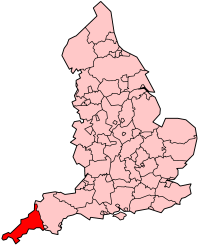
Cornwall's Location within England |
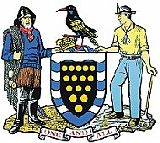
Cornwall's Coat of Arms |
- Penwith
- Kerrier
- Carrick
- Restormel
- Caradon
- North Cornwall
- Isles of
Scilly (Unitary)
|
Cornwall
(Cornish: Kernow or occasionally Curnow) is a county of England's south-west
peninsula, lying west of the River Tamar.
Cornwall's county
town and only city is Truro, situated
at 50° 15' 48 N, 5° 03' 04 W. The county covers an area of 1,376
square miles (3,563 km²), and includes the Isles of Scilly, 28 miles
offshore. Cornwall has a relatively low population
at 513,527, and population density at 144 people per square kilometre.
Cornwall is the poorest region in the United Kingdom.
Somewhere between
6% and 55% (sources differ) of Cornish people do not consider themselves
to be English, and regard Cornwall as a Celtic
home nation and Duchy of the UK. It should be noted that Cornwall,
the county, has been described as a Duchy on occasion by official bodies.
The revival of the Cornish language in the 20th century has boosted Cornish
cultural identity, and although currently less than 0.1% of the population
speak it fluently, it is taught in many schools and used in religious
and civic ceremonies.
| Motto: |
Onan hag oll
(Cornish: One and all) |
| Geography |
| Status |
Ceremonial and
(smaller) Non-metropolitan county |
| Region |
South West England
|
Area
- Total
- Admin Council
- Admin Area |
anked 12th
3,563 km²
Ranked 9th
3,547 km² |
| Admin HQ |
Truro |
| ISO 3166-2 |
GB-CON |
| ONS code |
15 |
| NUTS 3 |
UKK30 |
| Demographics |
Population
- Total (2003 est.)
- Density
- Admin Council
- Admin Pop
|
Ranked 40th
513,527
144 / km²
Ranked 24th
511,398 |
| Ethnicity |
99.0% White |
| Politics
|
| Executive |
Liberal Democrat
|
| Members of Parliament |
Julia Goldsworthy
Dan Rogerson
Colin Breed
Andrew George
Matthew Taylor |
History
The modern English
name is likely to derive from the same root as Wales (Walea, meaning foreigner)
combined with its Roman name of Cornubia. It is also proposed that it
may derive from the Celtic tribe of the Cornovii. A people of this name
are known, from Roman sources, to have lived in the Outer Powys to Shropshire
area of the later Wales and England.
One theory suggests that a contingent was sent to the West Country in
order to rule the land there and keep out the invading Irish. A similar
situation occurred in North Wales. However, there is no evidence for this
move west, and Cornish place names of a similar age indicate that there
was an independent tribe of Cornovii in the West Country. The Romans knew
the area as Cornubia, probably a sub-kingdom of the greater Dumnonia that
covered much of the West Country at that time, while in Cornish it was
known as Kernow or Curnow; a name which has regained some currency today.
It is worthy of note that on many maps produced before the 18th century
Cornwall was depicted as a nation of Great Britain;
famous example are Gerardus Mercator's Atlas and the famous Mappa Mundi.
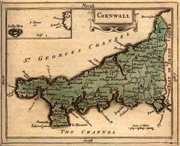 Cornwall
was the principal source of tin for the civilisations of the ancient Mediterranean,
and at one time the Cornish were the world's foremost experts at mining.
As Cornwall's reserves of tin began to be exhausted many Cornishmen emigrated
to places such as the Americas, Australia, New Zealand and South Africa
where their skills were in demand. The Cornish Rebellion of 1497 is attributed
to Tin miners. The tin mines in Cornwall are now
economically worked-out at current prices, but the expertise and culture
of the Cornish tin miners lives on in a number of places around the world.
It is said that, wherever you may go in the world, if you see a hole in
the ground, you'll find a Cornishman at the bottom of it. Several Cornish
mining words are in use in English language mining terminology, such as
costean, gunnies, and vug. Cornwall
was the principal source of tin for the civilisations of the ancient Mediterranean,
and at one time the Cornish were the world's foremost experts at mining.
As Cornwall's reserves of tin began to be exhausted many Cornishmen emigrated
to places such as the Americas, Australia, New Zealand and South Africa
where their skills were in demand. The Cornish Rebellion of 1497 is attributed
to Tin miners. The tin mines in Cornwall are now
economically worked-out at current prices, but the expertise and culture
of the Cornish tin miners lives on in a number of places around the world.
It is said that, wherever you may go in the world, if you see a hole in
the ground, you'll find a Cornishman at the bottom of it. Several Cornish
mining words are in use in English language mining terminology, such as
costean, gunnies, and vug.
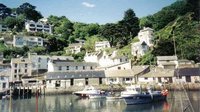 In
1841 there were nine hundreds of Cornwall: Stratton,
Lesneweth and Trigg; East and West; Powder; Pydar; Kerrier and Penwith.
The shire suffix has been attached to several of these, notably: the first
three formed Triggshire; East and West appear to be divisions of Wivelshire;
Powdershire and Pydarshire. The old names of Kerrier and Penwith have
been re-used for modern local government districts. Caradon, Carrick,
Kerrier, North Cornwall, Penwith, Restormel, and the Isles of Scilly compose
the modern civil parishes of Cornwall. In
1841 there were nine hundreds of Cornwall: Stratton,
Lesneweth and Trigg; East and West; Powder; Pydar; Kerrier and Penwith.
The shire suffix has been attached to several of these, notably: the first
three formed Triggshire; East and West appear to be divisions of Wivelshire;
Powdershire and Pydarshire. The old names of Kerrier and Penwith have
been re-used for modern local government districts. Caradon, Carrick,
Kerrier, North Cornwall, Penwith, Restormel, and the Isles of Scilly compose
the modern civil parishes of Cornwall.
Since the decline
of tin mining, agriculture and fishing, the area's economy has become
increasingly dependent on tourism — some of Britain's most spectacular
coastal scenery can be found here. However Cornwall
is the poorest county in England
and it has been granted Objective 1 status by the EU. A political party,
Mebyon Kernow, the MK, or 'Sons of Cornwall', was formed in 1951 to attempt
to assert some degree of autonomy; although increasingly the flag of St.
Piran is seen across Cornwall at protests and
demonstrations, the party has not achieved significant success at the
ballot box, although they do have some councillors.
Recently there have
been some developments in the recognition of Cornish identity or ethnicity.
In 2001 for the first time in the UK the inhabitants of Cornwall
could record their ethnicity as Cornish on the national census and in
2004 the schools census in Cornwall carried a
Cornish option as a subdivision of white British.
Geography
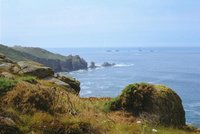 Cornwall,
being exposed to the full force of the Atlantic Ocean, is composed entirely
of resistant rocks, as less resistant rocks have been eroded away. The
centre of the county is largely Devonian sandstone and slate. The north
east of the county lies on Carboniferous sandstone. Cornwall
is particularly known for its igneous outcrops, which include the granite
of Bodmin Moor and the areas around Camborne
and Land's End, and the dark green serpentine of the Lizard Peninsula.
The granite forms high treeless moors on which sheep graze, and the characteristic
Cornish cliffs. Cornwall,
being exposed to the full force of the Atlantic Ocean, is composed entirely
of resistant rocks, as less resistant rocks have been eroded away. The
centre of the county is largely Devonian sandstone and slate. The north
east of the county lies on Carboniferous sandstone. Cornwall
is particularly known for its igneous outcrops, which include the granite
of Bodmin Moor and the areas around Camborne
and Land's End, and the dark green serpentine of the Lizard Peninsula.
The granite forms high treeless moors on which sheep graze, and the characteristic
Cornish cliffs.
Cornwall
is the southernmost county of the British Isles, and therefore has a relatively
warm and sunny climate. However, being unprotected from the Atlantic it
also has more extreme weather. The average annual temperature for most
of the county is 10.2 to 12 degrees Celsius, with slightly lower temperatures
on the moors. The county has relatively high rainfall, though less than
more northern areas of the west coast, at 1051 to 1290 mm per year. Most
of the county enjoys over 1541 hours of sunshine per year.
Politics
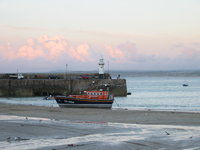 Parliamentary
representation for Cornwall is dominated by the
Liberal Democrats. Currently all five of the Cornish MPs are Liberal Democrat.
Two of the current MPs — Andrew George, MP for St Ives; and Dan
Rogerson, MP for North Cornwall — repeated their Parliamentary oaths
in Cornish. The local councils also have a large portion of Lib Dem members.
Most local Liberal Democrat MPs and councillors strongly support moves
for devolved agencies and governance to Cornwall,
as do some Welsh nationalists. Parliamentary
representation for Cornwall is dominated by the
Liberal Democrats. Currently all five of the Cornish MPs are Liberal Democrat.
Two of the current MPs — Andrew George, MP for St Ives; and Dan
Rogerson, MP for North Cornwall — repeated their Parliamentary oaths
in Cornish. The local councils also have a large portion of Lib Dem members.
Most local Liberal Democrat MPs and councillors strongly support moves
for devolved agencies and governance to Cornwall,
as do some Welsh nationalists.
Although Cornwall
is a county of England, an
independence movement exists that seeks more autonomy. Additionally some
groups and individuals question the constitutional status of Cornwall
and its relation to the Duchy of Cornwall. Cornish nationalists have organised
into two political parties: Mebyon Kernow and the Cornish Nationalist
Party. In addition to the political parties the Cornish Stannary Parliament
acts as a pressure group on Cornish constitutional issues and Cornwall
2000 the Human Rights organisation works with Cornish cultural issues.
In November 2000 the
Cornish Constitutional Convention was formed. It is a cross-party organisation
including representatives from the private, public and voluntary sectors,
of all political parties and none.
Between 5 March 2000
and December 2001, the campaign for a Cornish Assembly collected the signatures
of 41,650 Cornish residents endorsing the Declaration for a Cornish Assembly,
in total 50,546 including people outside Cornwall.
The British government however has no plans to devolve more power to Cornwall
and the issue does not receive much political or media attention. Cornwall
is one of the smaller counties by population and has around a fifth of
the population of what is the smallest region of England.
Flag
 There
is some dispute about whether the patron saint of Cornwall
is Saint Michael, Saint Petroc or Saint Piran. Saint Piran is the most
popular of the three; his emblem (a vertical white cross on a black background)
is recognised as the flag of Cornwall, and his
day (March 5) is celebrated by Cornish people around the world. The Saint
Piran's Flag even features on the packaging for Ginster's Cornish pasties
to advertise their status as a Cornwall-based company. There
is some dispute about whether the patron saint of Cornwall
is Saint Michael, Saint Petroc or Saint Piran. Saint Piran is the most
popular of the three; his emblem (a vertical white cross on a black background)
is recognised as the flag of Cornwall, and his
day (March 5) is celebrated by Cornish people around the world. The Saint
Piran's Flag even features on the packaging for Ginster's Cornish pasties
to advertise their status as a Cornwall-based company.
Demographics
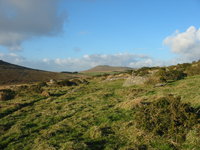 Cornwall's
population is 513,527, and population density 144 people per square kilometre,
ranking the county 40th and 41st respectively compared to the other 47
counties of England. Cornwall has a relatively
high level of population growth, however, at 11.2% in the 1980s and 5.3%
in the 1990s, giving it the fifth highest population growth of the English
counties. The natural change has been a small population decline, and
the population increase is due to immigration into the county. Cornwall's
population is 513,527, and population density 144 people per square kilometre,
ranking the county 40th and 41st respectively compared to the other 47
counties of England. Cornwall has a relatively
high level of population growth, however, at 11.2% in the 1980s and 5.3%
in the 1990s, giving it the fifth highest population growth of the English
counties. The natural change has been a small population decline, and
the population increase is due to immigration into the county.
Cornwall
has a relatively high retired population, with 22.9% of pensionable age,
compared to 20.3% for the United Kingdom. This may be due to a combination
of Cornwall's rural and coastal geography, popular as a retirement location,
and due to the emigration of younger residents to more economically diverse
areas.
Economy
Cornwall
is the poorest region in the United Kingdom. The GDP is 62% of the national
average. Cornwall is one of four UK regions that
qualifies for poverty-related grants from the EU (European Social Fund).
Today, the Cornish economy depends heavily on its successful tourist industry,
which makes up around a quarter of the Cornish economy. In particular,
Newquay is a popular destination for surfers. In recent years, the Eden
Project has been a major financial success.
Other industries are
fishing, although this has been significantly damaged by EU fishing policies,
and agriculture, which has also declined significantly. Mining of tin
and copper was also an industry, but today no longer exists, and several
defunct mines have applied for status as UNESCO World Heritage Sites.
Culture
Language
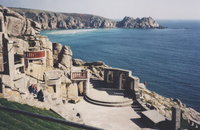 The
Cornish language is closely related to Welsh and Breton, and less so to
Irish, Scots Gaelic and Manx. It continued as a living Celtic language
until 1777 and the death of Dolly Pentreath, the last person thought to
have used only the Cornish language (although this is disputed on a number
of counts). The publication of Henry Jenner's "Handbook of the Cornish
Language" in 1904 caused a resurgence of interest in the Cornish
language and efforts are being made to revive it. Although there has never
been a census, there are some 2,000 Cornish speakers, 100–150 of
whom are fluent. It has recently been officially recognised by the UK
government as a minority language. The
Cornish language is closely related to Welsh and Breton, and less so to
Irish, Scots Gaelic and Manx. It continued as a living Celtic language
until 1777 and the death of Dolly Pentreath, the last person thought to
have used only the Cornish language (although this is disputed on a number
of counts). The publication of Henry Jenner's "Handbook of the Cornish
Language" in 1904 caused a resurgence of interest in the Cornish
language and efforts are being made to revive it. Although there has never
been a census, there are some 2,000 Cornish speakers, 100–150 of
whom are fluent. It has recently been officially recognised by the UK
government as a minority language.
Some Cornish surnames
are prefixed by Tre, Pol, or Pen, as indicated in the rhyme "by Tre,
Pol and Pen ye shall know Cornishmen." These come from Cornish language
words meaning, respectively, town (or farm), pool, and head.
Cornish studies and literary
references
The Institute of
Cornish Studies, established in 1970, is a branch of the University of
Exeter, and now part of the Combined Universities in Cornwall
Campus at Tremough, Penryn.
Philip Payton, professor Cornish studies, has written a history of Cornwall
as well as editing the Cornish studies series, and other academics, including
Mark Stoyle of the University of Southampton and John Angarrack of the
human rights organisation Cornwall 2000, have also produced work on Cornish
culture.
A detailed overview
of literature is provided by A. M. Kent's 'The Literature of Cornwall'.
It covers everything from Medieval mystery plays to more recent literary
works that draw on the Cornish landscape. Notable Cornish writers include
Arthur Quiller-Couch alias "Q", the deaf short story writer,
Jack Clemo and D. M. Thomas acclaimed author and poet.
Cornwall
also produced a substantial amount of passion plays during the Middle
Ages. Many are still extant, and provide valuable information about the
Cornish language.
Daphne du Maurier
lived in Cornwall and set many of her novels there,
including Rebecca, Jamaica Inn, Frenchman's Creek, My Cousin Rachel, and
The House on the Strand. She is also noted for writing Vanishing Cornwall.
Charles de Lint's novel The Little Country, Winston Graham's series Poldark,
Kate Tremayne's Adam Loveday series, Susan Cooper's novels Over Sea, Under
Stone and Greenwitch, Mary Wesley's The Camomile Lawn and Gilbert and
Sullivan's musical The Pirates of Penzance are all set in Cornwall.
Religion
Traditionally, the
Cornish have been nonconformists, in religion. Celtic Christianity was
a feature of Cornwall and many Cornish saints
are commemorated in legends, churches and place names.
The Methodism of John
Wesley also proved to be very popular with the working classes in Cornwall
in the 18th century. Cornwall has shared in the
post-World War II decline in British religious feeling.
In 2003, a campaign
group was formed called Fry an Spyrys (free the spirit in Cornish). It
is dedicated to disestablishing the Church of England in Cornwall.
Music and festivals
Cornwall
has a rich and vibrant folk music tradition which has survived into the
present. Cornwall is well known for its unusual
folk survivals such as Mummers Plays, the Furry Dance in Helston, and
Obby Oss in Padstow.
Cornish players are
regular participants in inter-Celtic festivals, and Cornwall
itself has several lively inter-Celtic festivals such as Perranporth's
folk festival.
Sports and games
Cornwall
has its own unique form of wrestling related to Breton wrestling.
Cornwall's other county
sport is hurling, a kind of medieval football played with a silver ball.
Hurling is distinct from Irish Hurling. The sport now takes place in St
Columb and St Ives although
hurling of a silver ball is part of the beating the bounds ceremony at
Bodmin every five years.
Rugby has a larger
following in Cornwall than football, with the
Cornish Pirates RFC, Launceston RFC and Redruth RFC in the national leagues.
The county team often drawing very large crowds of supporters, dubbed
Trelawny's Army.
Due to its large coastline,
various maritime sports are popular in Cornwall,
notably sailing and surfing. International events in both are held in
Cornwall. Cornwall will
host the Inter-Celtic Watersports Festival in 2006.
Euchre is a popular
card game in Cornwall, it is normally a game for
four players consisting of two teams. Its origins are unclear but some
claim it is a Cornish game. There are several leagues in Cornwall
at present.
Food
Cornwall
is famous for its pasties (a pastry dish - traditionally a Cornish Pasty
contains meat and vegetables, often peppered), but saffron buns, Cornish
Heavy (Hevva) Cake, Cornish fairings (biscuit), Cornish fudge and Cornish
ice cream are also quite common.
Cornwall
with the South West shares clotted cream and many types of cider. There
are also many types of beers brewed in Cornwall–
the St Austell brewery is the best-known – including a stout and
there is some small scale production of wine.
Rodda's cream (a creamery
based in Cornwall) is eaten by the queen at Christmas.
Settlements
This is a list of
the main towns and cities in the county.
- Bodmin,
Boscastle, Bude
- Camborne,
Charlestown, Coverack
- Falmouth,
Fowey
- Hayle,
Helston
- Launceston,
Liskeard, Lizard,
Looe
- Marazion,
Mevagissey, Mousehole
- Newlyn,
Newquay, Newtown
- Padstow,
Penzance
- Redruth
- Saltash,
St Austell, St
Ives, St Just in
Penwith, St Mawes
- Truro
- Wadebridge
Places of Interest
- Bodmin and
Wenford Railway
- Bodmin Moor
- Carn Euny
- Carrick
Roads
- Chûn
Castle
- Chûn
Quoit
- Cornwall
Wildlife Trust
- Eden Project
- Godrevy
Island
- Goonhilly
Downs
|
- Gweek seal
sanctuary
- Kynance
Cove
- Land's End
- Lanhydrock
House
- Lanyon Quoit
- The Lizard
- Loe Pool
- Lost Gardens
of Heligan
- Mên-an-Tol
|
- Minack Theatre
- Mullion Cove
- Pendennis
Castle
- Penlee House
- Poldhu
- Polperro
- Museum of
Submarine Telegraphy
- Restormel
Castle
- River Fowey
|
- River Looe
- Roseland
Peninsula
- South West
Coast Path
- St Mawes
Castle
- St Michael's
Mount
- Tintagel
Castle
- Trelissick
Gardens
- Truro Cathedral
|
The Isles of Scilly
have in some periods been served by the same county administration as
Cornwall, but are today a separate Unitary Authority.
Some secessionists have found the phrase "English Heritage"
to be controversial, and in 2003, there has been a general move to replace
these signs, and the Tudor Rose with the Cornish flag, after a group started
removing them.
Transport
Cornwall
borders the county of Devon at the River Tamar. Major
road links between Cornwall and the rest of England
are the A38 which crosses the Tamar at Plymouth
via the Tamar Bridge, and the A30 which crosses the border south of Launceston.
A car ferry also links Plymouth with
the town of Torpoint on the opposite
side of the Hamoaze. A rail bridge, the Royal Albert Bridge, built by
Isambard Kingdom Brunel (1859) provides the only other major transport
link.
Newquay
has an airport which has flights from London Gatwick, London Stansted,
Bristol, Manchester,
Leeds Bradford, Dublin, Birmingham,
Durham Tees Valley and a flight to Málaga has recently been announced.
The airport shares RAF St Mawgan's runways and facilities; however, this
is under threat as the Ministry of Defence is planning to mothball the
base.
|






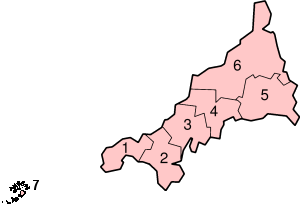

 In
1841 there were nine hundreds of
In
1841 there were nine hundreds of 
 Parliamentary
representation for
Parliamentary
representation for  There
is some dispute about whether the patron saint of
There
is some dispute about whether the patron saint of  Cornwall's
population is 513,527, and population density 144 people per square kilometre,
ranking the county 40th and 41st respectively compared to the other 47
counties of England.
Cornwall's
population is 513,527, and population density 144 people per square kilometre,
ranking the county 40th and 41st respectively compared to the other 47
counties of England.  The
Cornish language is closely related to Welsh and Breton, and less so to
Irish, Scots Gaelic and Manx. It continued as a living Celtic language
until 1777 and the death of Dolly Pentreath, the last person thought to
have used only the Cornish language (although this is disputed on a number
of counts). The publication of Henry Jenner's "Handbook of the Cornish
Language" in 1904 caused a resurgence of interest in the Cornish
language and efforts are being made to revive it. Although there has never
been a census, there are some 2,000 Cornish speakers, 100–150 of
whom are fluent. It has recently been officially recognised by the UK
government as a minority language.
The
Cornish language is closely related to Welsh and Breton, and less so to
Irish, Scots Gaelic and Manx. It continued as a living Celtic language
until 1777 and the death of Dolly Pentreath, the last person thought to
have used only the Cornish language (although this is disputed on a number
of counts). The publication of Henry Jenner's "Handbook of the Cornish
Language" in 1904 caused a resurgence of interest in the Cornish
language and efforts are being made to revive it. Although there has never
been a census, there are some 2,000 Cornish speakers, 100–150 of
whom are fluent. It has recently been officially recognised by the UK
government as a minority language.